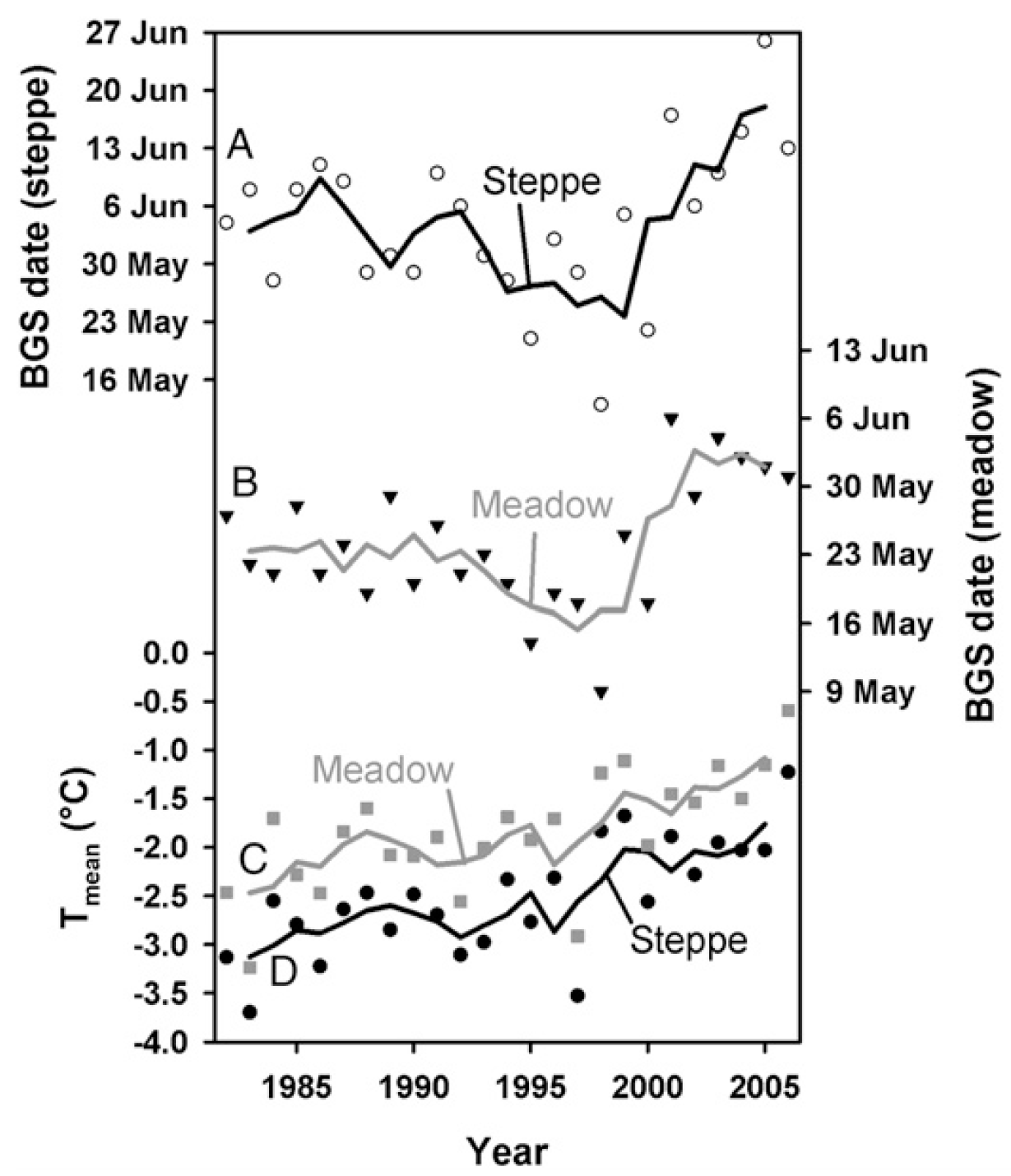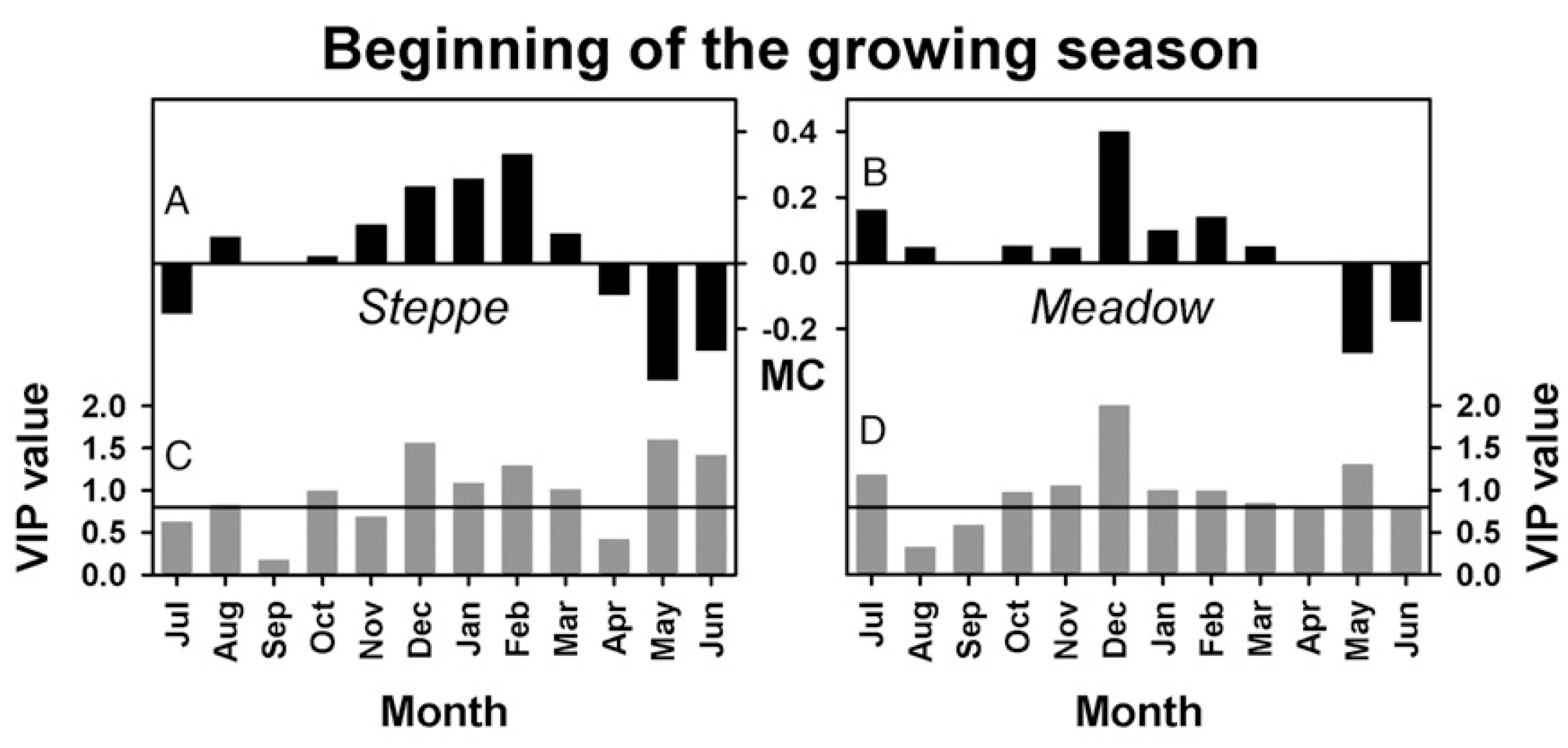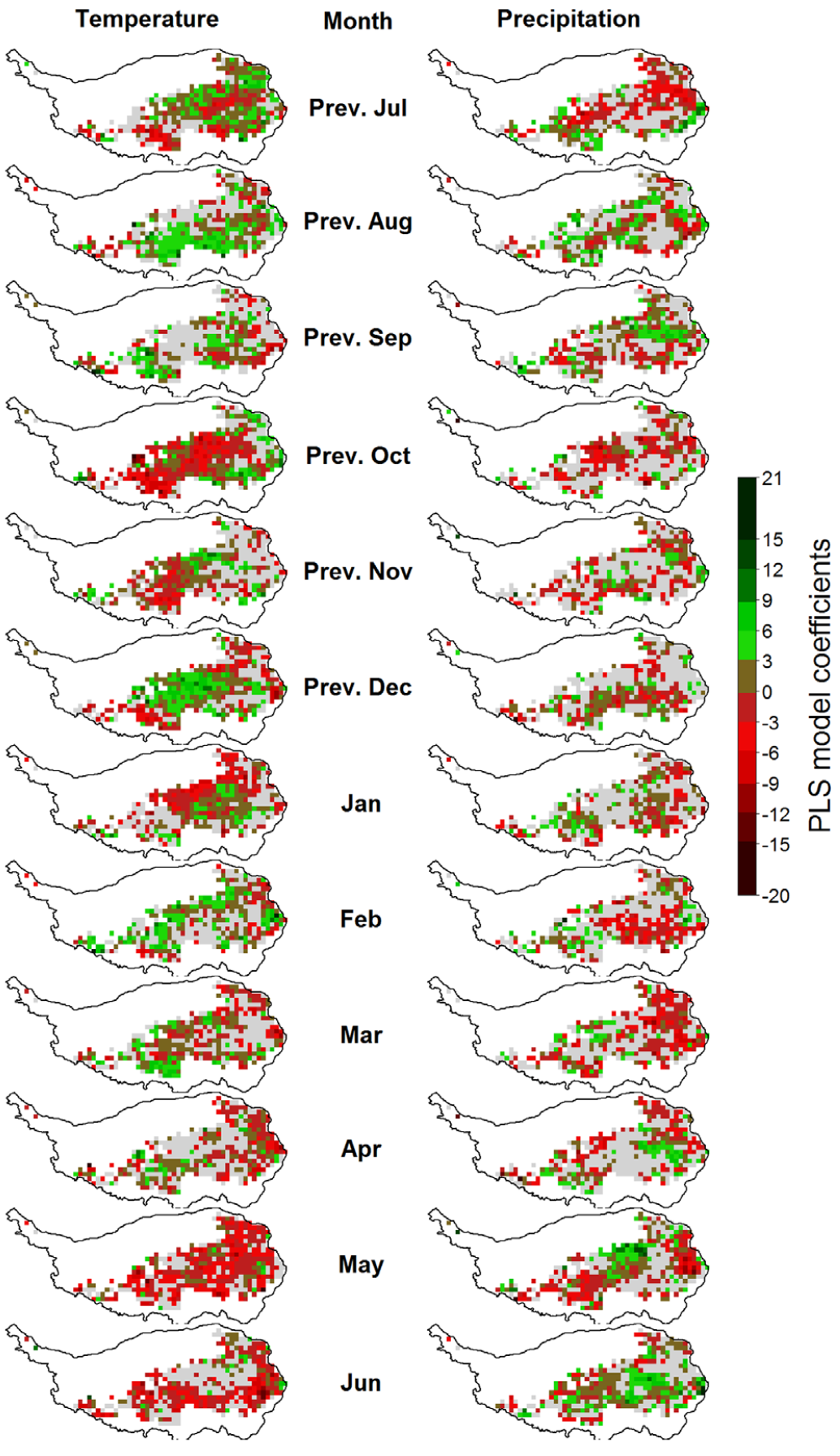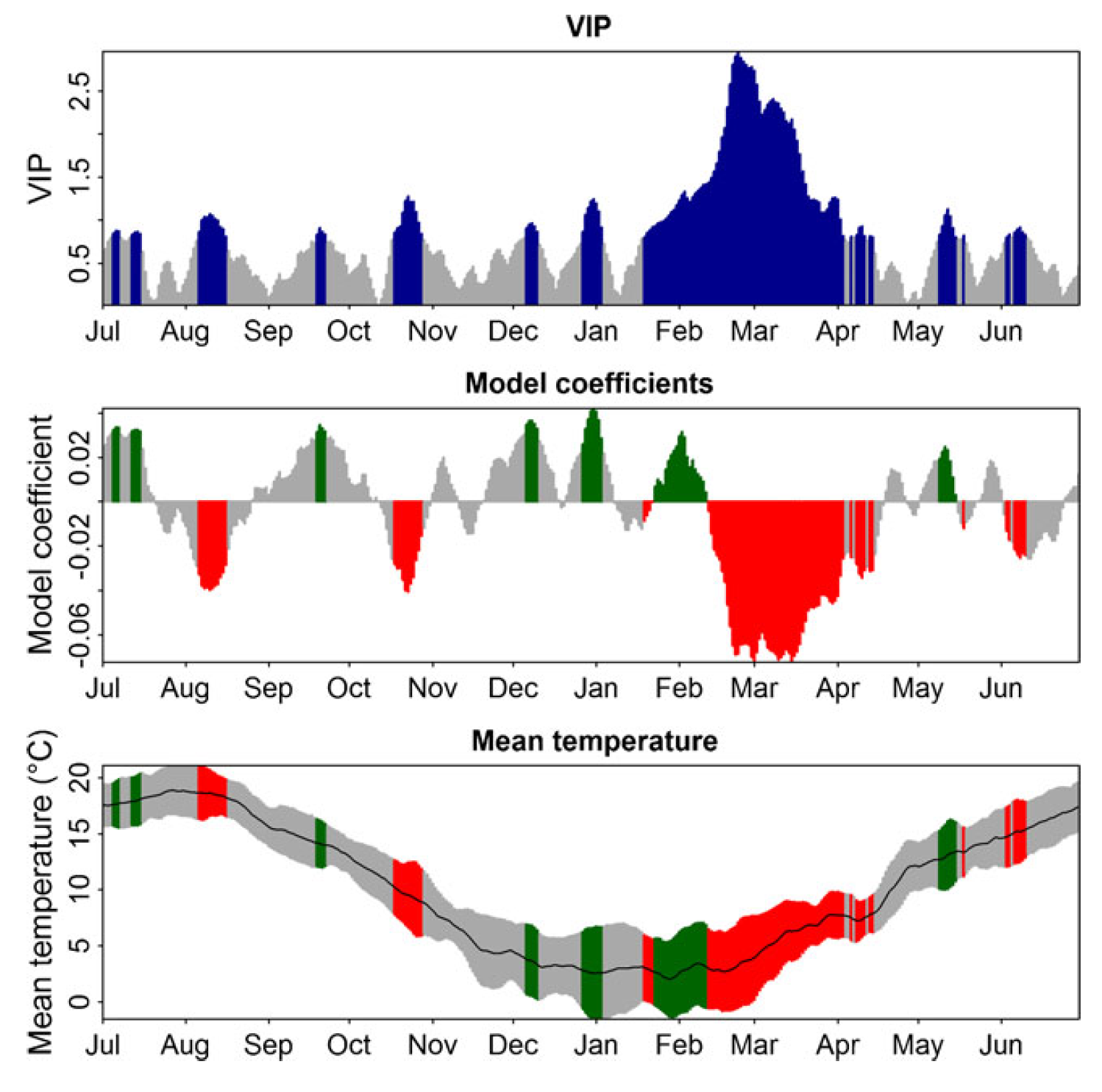Chapter 20 Successes and limitations of PLS regression analysis
Learning goals for this lesson
- Learn about the mixed success of applying PLS regression in various contexts
- Understand important limitations of PLS regression
20.1 PLS regression
We learned about Projection-to-Latent-Structures (PLS) regression (also known as Partial Least Squares regression) in the previous lesson. In the context of phenology analysis, we can use this method to correlate high-resolution temperature data (e.g. daily data) with low-resolution (annual) data on the timing of phenology events. We realized already, however, that in the case of pears at Klein-Altendorf we were only really able to recognize the forcing period (where warm conditions advance bloom), while the chilling face remained obscure. This was a bit disappointing, because the two dormancy phases had emerged quite clearly in the study on walnut leaf emergence in California. Let’s look at a few more examples to understand where and when this works - and to try to figure out why.
20.2 PLS examples
20.2.1 Grasslands on the Tibetan Plateau
In one of our first applications of the PLS methodology, we evaluated the temperature responses of grasslands on the Tibetan Plateau. Specifically, we looked at how the beginning of the growing season has responded to climate change. When we just look at the trend over time, the pattern that emerges is rather confusing, with a fairly clear advancing trend until the late 1990s, followed by a surprising delay in ‘green up’ dates.

Beginning of the growing season (BGS) for steppe (A) and meadow (B) vegetation on the Tibetan Plateau between 1982 and 2006, derived from 15-day NDVI composites obtained from the Advanced Very High Resolution Radiometer (AVHRR) sensor. BGS dates advanced markedly between 1982 and the mid 1990s, before retreating significantly after that. Consistent increases in temperature (C and D) indicate that observed changes are not linear responses to temperature. Lines in the graph represent 3-year running means (Yu, Luedeling, and Xu 2010)
Similar to what we found for walnuts in California, we detected a conspicuous relationship between warm temperatures in winter and delayed beginning of the growing season in spring.

Response of the BGS (A–D) in steppe and meadow vegetation of the Tibetan Plateau between 1982 and 2006 to monthly temperatures, according to PLS regression. The variable importance plots (VIP; C and D) indicate that temperatures in both spring (May and June) and winter (October through March) were important for explaining the response of BGS dates (VIP values above 0.8). Model coefficients (MC) of the centered and scaled data showed that warm winter temperatures delayed spring phenology (positive coefficients), whereas warm spring temperatures advanced the BGS (negative coefficients) for both steppe (A) and meadow (B). Including both effects into phenological models could substantially enhance our understanding of climate-change effects on vegetation at temperate and cold locations (Yu, Luedeling, and Xu 2010)
We later added a spatial component to this analysis, investigating vegetation responses to temperature at a pixel-by-pixel level.

Correlations of monthly temperatures (left) and precipitation (right) with the beginning of the growing season (BGS) on the Tibetan Plateau, according to Partial Least Squares (PLS) regression. For each variable, pixels for which the variable-importance-in-the-projection score was <0.8 are shown in gray. Pixels with insufficient data for PLS analysis are shown in white (Yu et al. 2012)
In principle, the temperature response pattern of grasslands is thus similar to what we’ve seen for walnuts in California. The mechanisms at work here are probably quite different, so we should not jump to conclusions here without adequate knowledge of grassland ecology (which I don’t have). These findings are concerning, however, because our initial expectation would probably have been that increasing temperature allows vegetation to get going earlier in the year. Failure of the vegetation to keep up with increasingly available thermal resources indicates a possible mismatch of the established ecosystems with future climatic conditions. Such a mismatch is usually not sustainable, and it may open opportunities for invasive species that are better able to exploit the climatic ‘resources’ that will be available in the future. Well, since I don’t know much about what’s going on here ecologically, I’ll stop speculating here. Let’s rather turn our focus back to deciduous trees.
20.2.2 Deciduous trees
In many of the early PLS analyses of tree phenology, I collaborated with Guo Liang, who was then a PhD student at the Kunming Institute of Botany in China (working in the group of Xu Jianchu, who also runs the regional office of World Agroforestry that is responsible for East and Central Asia). Guo Liang has since become a Full Professor, now running his own group at Northwest A & F University of China.
In his first analysis, Guo Liang looked at the phenology of chestnuts grown in Beijing, China. Here are the findings:

Results of Partial Least Squares (PLS) regression correlating first flowering dates for chestnut at Beijing Summer Palace with 11-day running means of daily mean temperatures from the previous July to June. Blue bars in the top panel indicate VIP values greater than 0.8, the threshold for variable importance. In the middle and bottom panels, red color means the model coefficients are negative (and important), while the green color indicates positive (and important) relationships between flowering and temperature. The black line in the bottom figure stands for the mean temperatures, while the gray, green and red areas represent the standard deviation of daily mean temperatures for each day of the year (Guo et al. 2013)
Once again, we can quite clearly see the forcing period - the long period of consistent negative model coefficients from January to May. The chilling period is also somewhat visible, but model coefficients are much less consistent, with many ‘unimportant’ values and even some interruptions.
A similar analysis of cherry phenology from Campus Klein-Altendorf produced quite similar results:

Results of Partial Least Squares (PLS) regression of bloom dates for cv. ‘Schneiders späte Knorpelkirsche’ cherries in Klein-Altendorf, Germany, with 11-day running means of daily mean temperatures. The top panel shows Variable Importance in the Projection (VIP) scores, the middle panel model coefficients of the centered and scaled data, and the bottom panel mean temperatures (black line) and their standard deviation (grey areas). Blue bars in the top panel indicate values above 0.8, the threshold for variable importance. In the middle and bottom figures, data for these dates is shown in red whenever model coefficients are negative, and green when they are positive (Luedeling, Kunz, and Blanke 2013)
Also here, we see the pronounced forcing phase, which follows a chilling period that is difficult to delineate.
A common pattern that emerges here is that the forcing phase is clearly visible, while the chilling phase is hard to see. This is disappointing after the very clear pattern we found earlier in California:

Results of a PLS analysis relating leaf emergence dates of ‘Payne’ walnuts in California to mean daily temperature
20.2.3 Why we’re not seeing the chilling phase
Does failure of the chilling phase to show up in the output of the PLS regression indicate that the method isn’t as useful for this purpose as we initially thought? Well, let’s not give up so easily, but rather look at what exactly PLS is sensitive to.
In the spider mite example, PLS regression was sensitive to the amount of reflected radiation that reached the sensor, with greater reflectance at certain wavelengths, and lower reflectance at other wavelengths, indicating mite damage severity. In detecting the forcing phase, PLS responded to temperature, with higher temperatures indicating greater heat accumulation, which was in turn related to early bloom.
In all of these cases, changes in the response variable were monotonically related to changes in the signal, i.e. the greater the signal, the greater/smaller the response. The following figure illustrates why this doesn’t work for chill accumulation. Let’s look at the temperature ranges that the chill models respond to and compare this to the temperature range that we can observe at the three study locations during the winter months.
To determine the range of effective temperatures for the various chill models we’ve already worked with, let’s see how much chill they produce at various levels of constant temperatures (I’m ommitting chill days here, because this model doesn’t work with constant temperatures):
library(chillR)
library(dormancyR)
library(ggplot2)
library(reshape2)
library(kableExtra)
library(patchwork)
hourly_models <- list(Chilling_units = chilling_units,
Low_chill = low_chill_model,
Modified_Utah = modified_utah_model,
North_Carolina = north_carolina_model,
Positive_Utah = positive_utah_model,
Chilling_Hours = Chilling_Hours,
Utah_Chill_Units = Utah_Model,
Chill_Portions = Dynamic_Model)
daily_models<-list(Rate_of_Chill = rate_of_chill,
Exponential_Chill = exponential_chill,
Triangula_Chill_Haninnen = triangular_chill_1,
Triangular_Chill_Legave = triangular_chill_2)
metrics<-c(names(daily_models),names(hourly_models))
model_labels=c("Rate of Chill",
"Exponential Chill",
"Triangular Chill (Häninnen)",
"Triangular Chill (Legave)",
"Chilling Units",
"Low-Chill Chill Units",
"Modified Utah Chill Units",
"North Carolina Chill Units",
"Positive Utah Chill Units",
"Chilling Hours",
"Utah Chill Units",
"Chill Portions")
for(T in -20:30)
{hourly<-sapply(hourly_models, function(x) x(rep(T,1000)))[1000,]
temp_frame<-data.frame(Tmin=rep(T,1000),
Tmax=rep(T,1000),
Tmean=rep(T,1000))
daily<-sapply(daily_models, function(x) x(temp_frame))[1000,]
if(T==-20) sensitivity<-c(T=T,daily,hourly) else
sensitivity<-rbind(sensitivity,c(T=T,daily,hourly))
}
sensitivity_normal<-
as.data.frame(cbind(sensitivity[,1],
sapply(2:ncol(sensitivity),
function(x)
sensitivity[,x]/max(sensitivity[,x]))))
colnames(sensitivity_normal)<-colnames(sensitivity)
sensitivity_gg<-melt(sensitivity_normal,id.vars="T")
sensitivity_gg$value[which(sensitivity_gg$value<=0.001)]<-NA
chill<-
ggplot(sensitivity_gg,aes(x=T,y=factor(variable),size=value)) +
geom_point(col="light blue") +
scale_y_discrete(labels= model_labels) +
ylab("Chill model") +
xlab("Temperature (assumed constant, °C)") +
xlim(c(-30,40)) +
theme_bw(base_size=15) +
labs(size = "Chill \nWeight")
Now let’s summarize winter temperatures at the three locations, for which we’ve seen phenology responses above: Klein-Altendorf (Germany), Beijing (China) and Davis (California).
KA_temps_JD<-make_JDay(read_tab("data/TMaxTMin1958-2019_patched.csv"))
temps<-stack_hourly_temps(
KA_temps_JD[which(KA_temps_JD$JDay>305|KA_temps_JD$JDay<90),],
latitude=50.6)
hh<-hist(temps$hourtemps$Temp,breaks=c(-30:30), plot=FALSE)
hh_df<-data.frame(
T=hh$mids,
variable="Klein-Altendorf, Germany",
value=hh$counts/max(hh$counts))
hh_df$value[which(hh_df$value==0)]<-NA
Beijing_temps_JD<-make_JDay(read_tab("data/Beijing_weather.csv"))
temps<-stack_hourly_temps(
Beijing_temps_JD[which(Beijing_temps_JD$JDay>305|Beijing_temps_JD$JDay<90),]
,latitude=39.9)
hh<-hist(temps$hourtemps$Temp,breaks=c(-30:30), plot=FALSE)
hh_df_2<-data.frame(T=hh$mids,
variable="Beijing,
China",value=hh$counts/max(hh$counts))
hh_df_2$value[which(hh_df_2$value==0)]<-NA
Davis_temps_JD<-make_JDay(read_tab("data/Davis_weather.csv"))
temps<-stack_hourly_temps(
Davis_temps_JD[which(Davis_temps_JD$JDay>305|Davis_temps_JD$JDay<90),],
latitude=38.5)
hh<-hist(temps$hourtemps$Temp,breaks=c(-30:40), plot=FALSE)
hh_df_3<-data.frame(T=hh$mids,
variable="Davis, California",
value=hh$counts/max(hh$counts))
hh_df_3$value[which(hh_df_3$value==0)]<-NA
hh_df<-rbind(hh_df,hh_df_2,hh_df_3)
locations<-
ggplot(data=hh_df,aes(x=T,y=variable,size=value)) +
geom_point(col="coral2") +
ylab("Location") +
xlab("Temperature (between November and March, °C)") +
xlim(c(-30,40)) +
theme_bw(base_size=15) +
labs(size = "Relative \nfrequency")
To compare the plots, let’s combine them in one figure (using the patchwork package):
plot<- (chill +
locations +
plot_layout(guides = "collect",
heights = c(1,0.4))
) & theme(legend.position = "right",
legend.text = element_text(size=10),
legend.title = element_text(size=12))
plot
We already realized earlier that some of these models are probably pretty poor. So let’s simplify by only plotting chill according to the Dynamic Model:
chill<-
ggplot(sensitivity_gg[which(sensitivity_gg$variable=="Chill_Portions"),],
aes(x=T,y=factor(variable),
size=value)) +
geom_point(col="light blue") +
scale_y_discrete(labels= "Chill Portions") +
ylab("Chill model") +
xlab("Temperature (assumed constant, °C)") +
xlim(c(-30,40)) +
theme_bw(base_size=15) +
labs(size = "Chill \nWeight")
plot<- (chill +
locations +
plot_layout(guides = "collect",
heights = c(0.5,1))
) & theme(legend.position = "right",
legend.text = element_text(size=10),
legend.title = element_text(size=12))
plot
If we compare the effective chill ranges with winter temperatures at the three locations, we can see that in Klein-Altendorf and Beijing, temperatures are quite often cooler than the effective temperature range for chill accumulation. At Davis, this is rarely the case. Temperatures that are too warm for chill accumulation occur quite frequently at Davis, and occasionally at the other two locations.
This means that at Davis, it is reasonable to expect that warm temperatures in winter reduce chill accumulation. In the other two locations, this is not always the case. When it is relatively cold, warming may actually increase chill. When temperatures are relatively high, however, chill accumulation would be reduced by warming. At these two locations, there is thus no monotonic relationship between temperature and chill accumulation. In such a setting, we shouldn’t expect PLS regression to produce clear results.
In the next chapter, we’ll learn about a way to overcome this problem.
Exercises on chill model comparison
Please document all results of the following assignments in your learning logbook.
- Briefly explain in what climatic settings we can expect PLS regression to detect the chilling phase - and in what settings this probably won’t work.
- How could we overcome this problem?
References
Guo, Liang, Junhu Dai, Sailesh Ranjitkar, Jianchu Xu, and Eike Luedeling. 2013. “Response of Chestnut Phenology in China to Climate Variation and Change.” Agricultural and Forest Meteorology 180: 164–72. https://doi.org/10.1016/j.agrformet.2013.06.004.
Luedeling, Eike, Achim Kunz, and Michael M Blanke. 2013. “Identification of Chilling and Heat Requirements of Cherry Trees—a Statistical Approach.” International Journal of Biometeorology 57 (5): 679–89. https://doi.org/10.1007/s00484-012-0594-y.
Yu, Haiying, Eike Luedeling, and Jianchu Xu. 2010. “Winter and Spring Warming Result in Delayed Spring Phenology on the Tibetan Plateau.” Proceedings of the National Academy of Sciences 107 (51): 22151–6. https://doi.org/10.1073/pnas.1012490107.
Yu, Haiying, Jianchu Xu, Erick Okuto, and Eike Luedeling. 2012. “Seasonal Response of Grasslands to Climate Change on the Tibetan Plateau.” PLoS One 7 (11): e49230. https://doi.org/10.1371/journal.pone.0049230.